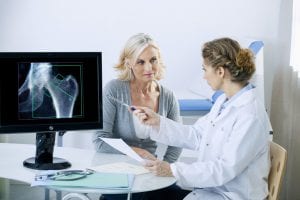Written by Taylor Woosley, Staff Writer. 12-month supplementation with 75 mg of >98% trans-resveratrol twice daily resulted in a BMD increase in the lumbar spine by 1.3%, along with increasing corresponding T-scores in the neck of femur and total hip compared to placebo.
 Osteoporosis is a systemic skeletal disease characterized by low bone mineral density (BMD) and deterioration of bone architecture, resulting in reduced bone strength and an increase in fracture susceptibility1. Estrogen plays an important role in maintaining BMD and a decrease in estrogen levels associated with menopause leads to a decrease in BMD that increases fracture risk2. During the menopausal transition, the average decrease in BMD is up to a 10-20% loss in the 5-7 years around menopause3.
Osteoporosis is a systemic skeletal disease characterized by low bone mineral density (BMD) and deterioration of bone architecture, resulting in reduced bone strength and an increase in fracture susceptibility1. Estrogen plays an important role in maintaining BMD and a decrease in estrogen levels associated with menopause leads to a decrease in BMD that increases fracture risk2. During the menopausal transition, the average decrease in BMD is up to a 10-20% loss in the 5-7 years around menopause3.
Phytoestrogens, such as resveratrol, are a group of polyphenols commonly used in the treatment of menopause-related conditions and the estrogenic activity of resveratrol include beneficial effects on osteoporotic bone loss4. Resveratrol exhibits important bioactivities including inhibiting the synthesis of reactive oxygen species5. Findings from in vitro rat experiments show that resveratrol promotes osteoblast differentiation and suppresses osteoclast differentiation6.
Wong et al. conducted a subgroup analysis of The Resveratrol Healthy Aging in Women (RESHAW) trial to assess the effects of resveratrol on bone health and biomarkers of bone metabolism. RESHAW was a randomized, double-blind, placebo-controlled, two-period crossover intervention of postmenopausal women supplementing resveratrol or placebo twice daily (morning and evening) for 24-months. Subjects were randomized to receive either 75 mg of >98% trans-resveratrol or placebo capsules for 12 months followed by a cross over to the alternate treatment for the remaining 12 months. Participants were informed to maintain physical activity levels and habitual nutrient intake.
BMD was measured at baseline and the end of each treatment phase by DXA. Fasted blood samples were obtained directly after DXA scanning and were used to assess plasma levels of osteocalcin and C-terminal telopeptide type-1 collagen (CTX). A subgroup analysis was completed to analyze potential interactions with resveratrol administration based on subjects’ baseline bone density T-score bone health classification in the hip and habitual intake of vitamin D or calcium supplements. Pearson’s correlation was utilized to test for an association between treatment change in cerebrovascular responsiveness and changes in BMD and T-scores.
After the first 12-month intervention phase, 63 women in the resveratrol group and 66 women in the placebo group participated in reassessments of outcomes measures. 125 women completed the 2-year crossover intervention. Significant findings of the study are as follows:
- 12-month supplementation with resveratrol resulted in a BMD increase in the lumbar spine by 1.3%, improving the mean T-score by 1.5% compared to placebo. Additionally, resveratrol intake increased BMD and corresponding T-scores in the neck of femur and total hip, in turn significantly reducing the 10-year probability of fracture risk.
- Results of the crossover analysis shows that, compared with placebo, resveratrol administration significantly improved BMD for the lumbar spine and neck of femur and experienced a significantly higher femoral neck T-score.
- Parallel analysis results show that participants in the resveratrol group supplementing with calcium (+0.068 g/cm2) or both vitamin D and calcium (+0.036 g/cm2) had a greater treatment difference from baseline in the lumbar spine BMD compared to subjects who did not supplement with calcium or vitamin D (+0.002 g/cm2).
Results of this sub analysis of RESHAW show that resveratrol supplementation improved the BMD of the lumbar spine and femoral neck, reducing the risk of fracture. These findings were even more pronounced in subjects supplementing with calcium and vitamin D. Further human clinical trials are necessary to comprehend the effects of resveratrol on bone health.
Source: Wong, Rachel HX, Jay Jay Thaung Zaw, Cory J. Xian, and Peter RC Howe. “Regular supplementation with resveratrol improves bone mineral density in postmenopausal women: a randomized, placebo‐controlled trial.” Journal of Bone and Mineral Research 35, no. 11 (2020): 2121-2131.
© 2020 The Authors. Journal of Bone and Mineral Research published by American Society for Bone and Mineral Research.
Click here to read the full text study.
Posted November 14, 2023.
Taylor Woosley studied biology at Purdue University before becoming a 2016 graduate of Columbia College Chicago with a major in Writing. She currently resides in Glen Ellyn, IL.
References:
- Brown JP. Long-Term Treatment of Postmenopausal Osteoporosis. Endocrinol Metab (Seoul). Jun 2021;36(3):544-552. doi:10.3803/EnM.2021.301
- Słupski W, Jawień P, Nowak B. Botanicals in Postmenopausal Osteoporosis. Nutrients. May 11 2021;13(5)doi:10.3390/nu13051609
- Yong EL, Logan S. Menopausal osteoporosis: screening, prevention and treatment. Singapore Med J. Apr 2021;62(4):159-166. doi:10.11622/smedj.2021036
- Corbi G, Nobile V, Conti V, et al. Equol and Resveratrol Improve Bone Turnover Biomarkers in Postmenopausal Women: A Clinical Trial. Int J Mol Sci. Jul 27 2023;24(15)doi:10.3390/ijms241512063
- Zhang Y, Liu MW, He Y, et al. Protective effect of resveratrol on estrogen deficiency-induced osteoporosis though attenuating NADPH oxidase 4/nuclear factor kappa B pathway by increasing miR-92b-3p expression. Int J Immunopathol Pharmacol. Jan-Dec 2020;34:2058738420941762. doi:10.1177/2058738420941762
- Niwano Y, Kohzaki H, Shirato M, Shishido S, Nakamura K. Anti-Osteoporotic Mechanisms of Polyphenols Elucidated Based on In Vivo Studies Using Ovariectomized Animals. Antioxidants (Basel, Switzerland). Jan 23 2022;11(2)doi:10.3390/antiox11020217
